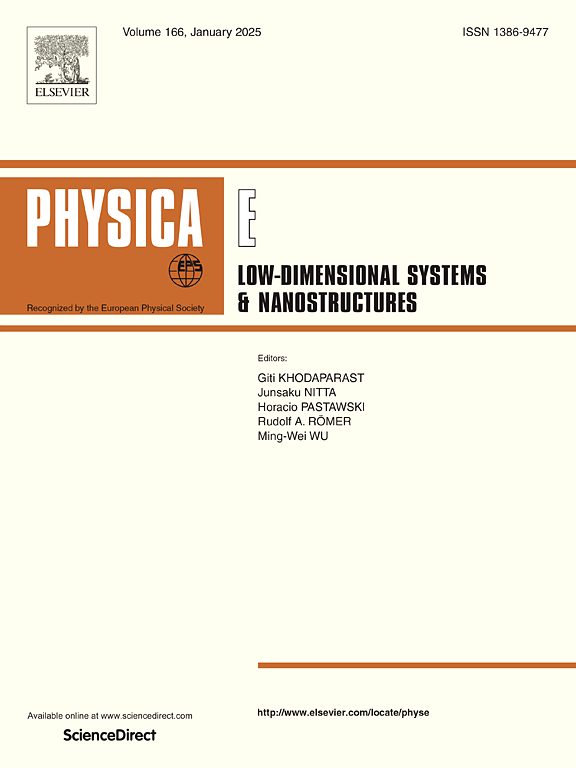Effect of screening on seebeck coefficient in bilayer graphene/AlGaAs electron gas
IF 2.9
3区 物理与天体物理
Q3 NANOSCIENCE & NANOTECHNOLOGY
Physica E-low-dimensional Systems & Nanostructures
Pub Date : 2025-01-14
DOI:10.1016/j.physe.2025.116194
引用次数: 0
Abstract
The knowledge of Seebeck coefficient is a key factor in optimization of thermoelectric materials and finding right applications for it. A high sensitivity to structural change makes thermopower measurements an excellent technique for the study on the charge transport properties of a given material. The phonon-drag term dominates at low temperature in the Seebeck coefficient. This study examines the temperature-dependent screening effect on the phonon-drag-induced Seebeck coefficient () in a bilayer graphene (BLG)-AlGaAs/quasi-two-dimensional electron gas (q2DEG) system at the temperature below 50 K. The BLG layer interacts with both deformation potential acoustic phonons and stronger piezoelectric field acoustic phonons from AlGaAs/GaAs. We compare the electron–phonon interactions in BLG with and without screening by q2DEG. The screening effect reduces , particularly at low temperatures, and shows a strong dependence on the carrier density in the BLG layer. The double-layer screening function increases with layer separation (d), paralleling the monolayer screening at large d. Additionally, varying the GaAs quantum well width reveals that increases with width less than 100 Å under double-layer screening but remains unchanged beyond this threshold, while monolayer screening decreases as the width increases. Both screening functions enhance when the BLG carrier density is lower than that of q2DEG, though the magnitude difference between them is minimal.
筛选对双层石墨烯/AlGaAs电子气体中塞贝克系数的影响
了解塞贝克系数是优化热电材料并找到合适应用的关键因素。对结构变化的高灵敏度使热功率测量成为研究给定材料的电荷输运性质的一种极好的技术。在塞贝克系数中,声子-阻力项在低温下占主导地位。本文研究了在低于50 K的温度下,双层石墨烯(BLG)-AlGaAs/准二维电子气体(q2DEG)体系中,温度对声子-阻力诱导的塞贝克系数(Sg)的筛选效应。BLG层与AlGaAs/GaAs的变形势声子和更强的压电场声子相互作用。我们比较了有q2DEG筛选和没有筛选的BLG中的电子-声子相互作用。筛选效果降低了Sg,特别是在低温下,并且显示出对BLG层载流子密度的强烈依赖性。双层屏蔽函数的Sg随层距的增加而增加(d),与单层屏蔽函数的d相当。此外,改变GaAs量子阱宽度表明,在双层屏蔽下,Sg随宽度小于100 Å而增加,但超过该阈值后保持不变,而单层屏蔽函数的Sg随宽度的增加而减小。当BLG载流子密度低于q2DEG时,两种筛选功能都能增强Sg,但两者之间的幅度差异很小。
本文章由计算机程序翻译,如有差异,请以英文原文为准。
求助全文
约1分钟内获得全文
求助全文
来源期刊
CiteScore
7.30
自引率
6.10%
发文量
356
审稿时长
65 days
期刊介绍:
Physica E: Low-dimensional systems and nanostructures contains papers and invited review articles on the fundamental and applied aspects of physics in low-dimensional electron systems, in semiconductor heterostructures, oxide interfaces, quantum wells and superlattices, quantum wires and dots, novel quantum states of matter such as topological insulators, and Weyl semimetals.
Both theoretical and experimental contributions are invited. Topics suitable for publication in this journal include spin related phenomena, optical and transport properties, many-body effects, integer and fractional quantum Hall effects, quantum spin Hall effect, single electron effects and devices, Majorana fermions, and other novel phenomena.
Keywords:
• topological insulators/superconductors, majorana fermions, Wyel semimetals;
• quantum and neuromorphic computing/quantum information physics and devices based on low dimensional systems;
• layered superconductivity, low dimensional systems with superconducting proximity effect;
• 2D materials such as transition metal dichalcogenides;
• oxide heterostructures including ZnO, SrTiO3 etc;
• carbon nanostructures (graphene, carbon nanotubes, diamond NV center, etc.)
• quantum wells and superlattices;
• quantum Hall effect, quantum spin Hall effect, quantum anomalous Hall effect;
• optical- and phonons-related phenomena;
• magnetic-semiconductor structures;
• charge/spin-, magnon-, skyrmion-, Cooper pair- and majorana fermion- transport and tunneling;
• ultra-fast nonlinear optical phenomena;
• novel devices and applications (such as high performance sensor, solar cell, etc);
• novel growth and fabrication techniques for nanostructures

 求助内容:
求助内容: 应助结果提醒方式:
应助结果提醒方式:


